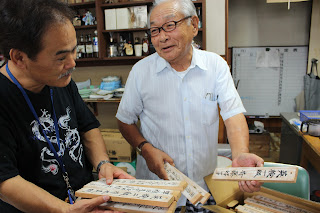People everywhere. That's what ordinary Japanese towns and villages look like, but not in Odaka. During our 2 hour long drive, we saw hardly anyone. That's the reality of life in Odaka and other places in the 20 KM evacuation zone. I tried to capture all that in the 7 minute video below (this is my very first movie!)
I had a privilege to meet Rev. Yusuke Yanagiya from Iwate who wrote the lyric of the song and it is below:
Sing to the LORD a New Song*
By Rev. Yusuke Yanagiya
A song cannot satisfy our hunger
A song cannot satisfy our hunger
It is true, it is so true.
But, let us sing together.
Our hearts may be filled.
A song cannot bring power back
A song cannot bring power back
It is true, it is so true.
But, let us sing together.
Our hearts may be illuminated.
A song cannot clear the rubble away
A song cannot clear the rubble away
It is true, it is so true.
But, let us sing together.
Our hearts may be lightened.
A song cannot build a house
A song cannot build a house
It is true, it is so true.
But, let us sing together.
Our hearts may be united.
Singing may sound hollow
I know sometimes it feels so
But, let the tears run
Let your heart be broken
Let us sing our true feelings
Somebody there to embrace you as you are.
A song cannot stop tsunami
No human hand could stop it
It is true, it is so true.
Therefore, let us sing together.
We may know the heart of God.
Translation from Japanese by Yusuke Yanagiya and Midori Yanagisawa.
English edit by Jonathan Wilson and Soohwan Park.
* This title is given by Jonathan and he describes: Events like the triple disaster in Fukushima call us back to God and to a deeper relationship with God in our pain, suffering, and disorientation. Out of that, like Israel in Psalm 96, we learn to sing a new song to the Lord.































